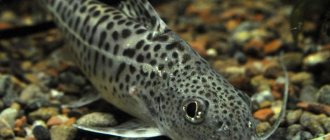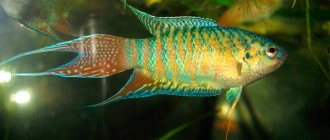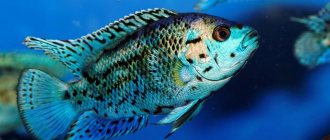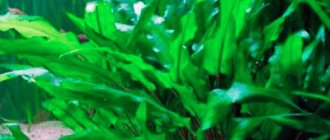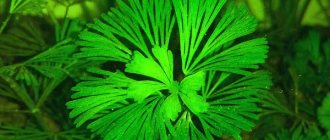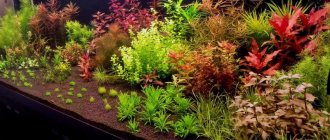What do you need
It is not difficult to provide complete care for plants in an aquarium, excluding rare, demanding species.
To do this you need:
- choose lighting;
- monitor the ground;
- add fertilizer as needed;
- check the condition of the water.
Light is a necessary condition for photosynthesis. Consider the lighting requirements of plants. There are those who love light, and there are those who feel more comfortable in the shadows.
The soil is laid up to 7 cm thick. It must be light so that the rooting process takes place quickly. Industrial fertilizers that can be purchased in stores contain the entire complex of minerals and macroelements necessary for plants. Water most often should be slightly acidic, but before planting a specific species, it is better to double-check the requirements.
Popular aquarium plants
The following is a brief look at plants that are often planted in aquariums. If you want to know everything about aquarium plants, then for each name or specific name you need to find more detailed information.
Anubias
A plant undemanding to environmental conditions, whose powerful roots grow up to 18–20 cm in length. It has large leaves and is suitable for aggressive fish. Barter's anubias and the dwarf subspecies anubias nana are used in aquariums. Nana grows up to 10–15 cm, prefers shady places in the pond.
Vallisneria
Large grass for the background or corners of the tank. The Vallisneria plant is demanding on environmental conditions, check the water parameters and make a change. There are three types used in aquarium farming: giant, dwarf and spiral. It grows quickly, can grow up to 1.5-2 meters, spreads along the surface of the water. You cannot trim the ends, only thin them out.
Water hyacinth
The second name of the species is Eichornia excellent. A plant with beautiful flowers that smell nice. It grows comfortably in warm conditions (water temperature 25–29 degrees), loves high light levels, even install additional lamps. Perfectly filters water. For hyacinth, it is necessary to leave an air gap of 20 cm above the surface of the water when the aquarium is closed.
Hydrocotyla
White-headed hydrocotyle (lat. hydrocotyle leucocephala) is also called Brazilian stinkhorn. This is one of the most resilient aquarium plants, able to withstand major changes in external conditions. Suitable for beginners. It grows very quickly and spreads along the surface of the water. Small white flowers bloom there too. In bright light they grow faster and vice versa. Regular pruning is required.
Hygrophiles
About 90 species of hygrophiles. These are unpretentious aquarium thickets. Baby fish hide in them. The more light, the faster the growth. Powerful root system, large leaves that turn red when exposed to excessive light. Requires periodic pruning. The most popular types: loosestrife, lemongrass and red.
Kabomba
Very beautiful lush bushes that look great in the corners of a water tank. The original green-red leaves are multi-directional. The root system is weak and needs to be strengthened. Fast, aggressive fish can damage leaves. Use for calm, slow-moving fish.
Krinum
Large grass for a large aquarium. Grows up to 50 cm in length. Needs warm (more than 22 degrees) water, turns yellow in cold water. For the soil, use gravel and peat so that the grass receives the necessary substances.
Cryptocoryne
Heat-loving bush, undemanding to environmental conditions. The shape resembles a bouquet made of 18–20 leaves. Grows up to 50 cm. Likes to be the only species in the aquarium. Cryptocoryne Wendt is a great choice for the foreground.
Limnobium
Representative of a genus of algae in an aquarium. Used to create shade in the tank. There are no roots, it floats on the surface of the aquarium. It receives all useful substances from water. Small leaves, 2–3 cm in size, under good conditions can completely cover the surface of the water, so it needs to be thinned out periodically.
Ludwigia
Algae with a weak root system. It can be planted in the ground, or it can drift along the surface of the aquarium. Loves warm water, more than 22 degrees. The original leaves are greenish-red in color. With proper lighting, the colors are very vibrant. Creeping Ludwigia (Ludwigia repens) is commonly used in aquariums.
Marsilia
The plant covers the bottom, undemanding to environmental conditions, and is an excellent shelter for fry. The leaves consist of four leaves fused together, similar to clover leaves. For planting in an aquarium, four-leaved Marsilia (lat. marsilea quadrifolia) is used.
Moss flame
The second name is “flame”. The name is due to the external shape. An undemanding moss that grows quickly, tightly fitting stem to stem. When moving in water, it looks like a green flame. It is better to plant at the bottom.
Phoenix moss
A type of aquatic moss that grows only when completely submerged in water. Phoenix moss is attached to stones, interior elements, and driftwood using rhizoids. Aquarists secure the moss with glue or rubber bands, which are removed after rooting. The leaves look like feathers. Without water it dries out. If placed in moisture, it quickly revives. Therefore the phoenix.
Java moss
Moss from Southeast Asia with pointed leaves, tightly placed on the stem, at an acute angle to it. Grows on snags and stones, attaching to them. Tolerant to fluctuations in external conditions. In an aquarium, Java moss is recommended to be planted away from feeders to protect it from contamination.
Thai fern
This species is also called Javanese. This aquarium plant is definitely suitable for a beginner aquarist. Very undemanding. Survives in almost any conditions. Even with leaf-eating fish, such as goldfish. There are several popular types of Thai fern that have different leaf shapes.
Riccia
Moss floating in the water column. It is necessary that the water temperature is 22 degrees or higher, and there is a sufficient level of lighting. Regular replacement of 20% of water is a necessary condition for care. Used for spawning and shelter for fry, as well as shading. Riccia has no roots, leaves, or stems, only plates that grow strongly.
Hornwort
Belongs to species that swim in the water column. The main requirements: water temperature 20–30 degrees, bright light, but not direct sunlight. Perfectly filters aquarium water from dirt and nitrates.
Christmas moss
Named because of their resemblance to the branches of spruce. Very beautiful, does not require special maintenance conditions. When planted on snags, it demonstrates its shape to the maximum.
Duckweed
Algae, which are small oval leaves floating on the surface of the water. They love light and can withstand significant temperature fluctuations. Used for shading and as food for fish. Ground, dried duckweed is an excellent source of vitamins.
Sitnyag needle-shaped
Marsh grass, which has bunches of thin leaves directed upward, 10–16 cm long. Eleocharis acicularis can withstand temperature fluctuations, but the water should be soft, slightly acidic. Regular water changes are required. The top of the plant should be exposed to air. Used for foreground.
Arrowhead
Subulate arrowhead (lat. sagittaria subulata) is a plant with long, fleshy green leaves. There is a clearly visible vein running down the middle of the leaf. Grows up to 25 cm tall. It is not recommended to plant with other plants. It doesn't develop well around them. Grows in different lighting conditions. Compatible with aggressive fish, such as cichlids.
Elodea
A fast-growing algae that can be planted in the ground or allowed to float freely in the tank. It grows up to 2 meters, so it requires regular pruning. Thin green lancet-shaped leaves. They are eaten by goldfish and mollies.
Echinodorus
Fast-growing marsh grass. Has no stems. Long dark green leaves grow directly from the roots. In favorable conditions, Echinodorus blooms. They need good lighting and CO2. Breeders are still breeding new subspecies.
Most Popular:
- Amazonian echinodorus amazonicus;
- delicate echinodorus tenellus;
- Echinodorus cordifolia;
- yarrow, etc.
Plants floating on the surface of the water
This is a group whose main life cycle takes place on the surface of a reservoir.
Pistia or water cabbage (Pistia stratiotes)
In my opinion, the most beautiful floating plant. Large, rosette-shaped leaves add charm to any aquarium. A prerequisite is the presence of sufficient space between the cover glass and the surface of the water.
Requires good lighting and low water current.
Those who want to have fish of the genus Betta (cockerels) should definitely pay attention to this plant. Imitation of natural habitat for fish is guaranteed.
Azolla
Azolla is a beautiful ornamental plant floating in an aquarium. If you let it grow quietly, you will be guaranteed a carpet of greenery. A small patch of grass quickly takes over new territory.
It suppresses the growth of algae quite well with its ability to “pump out” phosphorus and nitrogen compounds in large quantities. Undemanding to fertilizer additives, CO2. Water and light are all you need.
A unique feature of Azolla is the ability to change the green color of the leaves to rusty red with increasing light intensity. This is a consequence of a symbiotic interaction with cyanobacteria.
Salvinia
Salvinia is the best utilizer of nitrates contained in the aquarium. Hardy and unpretentious plant. Beautiful bushes on the surface create peace. However, in addition to light and liquid, normal growth of salvinia requires control over the operation of the aerator and filter in the aquarium. The higher the water flow, the smaller the plant.
Duckweed (Lemna)
Duckweed is ideal for all types of aqua cans. A plant with tiny leaves and short roots looks natural among larger forbs.
Regular removal of excess duckweed ensures a cozy environment. Especially for fish that prefer dim lighting. Serves as an excellent shelter for newborn fry and larvae.
It is worth mentioning the giant duckweed. Its long roots are simply a paradise for livebearers.
If you like the naturalness of your home pond and don’t mind periodically “cleaning” the population, then these floating plants are a must-have. However, I want to warn you. In the future, it is difficult to get rid of duckweed completely.
Limnobium
You can read about the contents of Limnobium here. Now I just want to add to what was said earlier that limnobiums are classic floating plants. The weed is very popular among amateurs because it is unpretentious and easy to maintain.
Riccia
Riccia often grows in an aquarium as an underwater plant, where it lines a beautiful carpet. However, even in a floating state, it can look chic. The main thing is not to let it grow.
With good lighting and plenty of carbon dioxide, floating Riccia tends to get out of the water. There, in a humid air environment, it acquires a more beautiful color.
It is an excellent building material for labyrinths. Small fish like to hide in its wilds.
Plant care
To properly care for aquarium plants, check the lighting, soil and water parameters. The light requirements of different species differ. For algae, the norm is 1 watt per 1 liter. Others need bright lighting, a certain temperature, acidity. Periodically measure water indicators with indicators. In the soil, use medium-sized sand and gravel for aeration. If necessary, fertilize the plants with fertilizers.
Landing rules
Before planting in the ground, clean each plant from adhering dirt, soak in a solution of potassium permanganate for 15–20 minutes, or rinse with a solution of hydrogen peroxide. Next, rinse with water and plant. When planting in the ground, make sure that the roots are directed downward and do not bend. Plant large, spreading bushes against the back wall. Medium sized plants on the sides or in the center. Covering the bottom and small ones are planted in front. And near the lamps are those who love bright lighting.
How many plants do you need?
Algae, bushes and herbs in the aquarium play an important, but not the main role. Therefore, plant according to your needs. Bushes should not interfere with the movement of active fish; for example, huge bushes will interfere with the movement of chromis. For spawning, when larvae attach to the leaves, plant 2-3 bushes with large leaves.
Light in the aquarium
Aquarium lighting plays an important role. Without it, the process of photosynthesis does not occur, and as a result, the fish do not receive enough oxygen.
For this purpose use:
- fluorescent lamps;
- energy saving;
- incandescent lamps;
- metal halide lamps.
There are lamps with an ultraviolet spectrum, under which plants develop better. Which one to choose depends on the fish living in the aquarium, the plants planted and financial capabilities.
Aquarium plants: maintenance and care
We must admit that caring for a home aquarium is not easy work, requiring not only effort and time, but also certain material costs. However, all this pays off handsomely when you admire the beauty of the underwater world, which, moreover, has a calming positive effect on the nervous system.
Depending on what kind of plants you plan to plant, you need to decide whether soil is needed in the future reservoir. Very fine gravel used for planting can be used for this purpose.
Perhaps the main parameter for successfully growing aquarium plants is lighting. For one liter you need to provide at least 0.75 watts of light. Depending on the type of vegetation, this indicator may vary. It is best to choose fluorescent lamps. If the height of the aquarium is more than half a meter, then mercury lamps will be preferable. Fluorescent lamps must be replaced every six months, since the intensity of their illumination tends to decrease over time.
Maintenance and care of aquarium plants
Water is the most important factor in the habitat of aquarium plants. It is in this environment that they live and develop. The standard is considered to be a hardness of 4 to 12 dH with an acidity of 6.5-7.2 pH. However, some types of vegetation have their own characteristics and preferences regarding these factors. This must definitely be read and taken into account. Under no circumstances should the water be cloudy or dirty. Due to the turbidity, light will not pass through well, and any dirt present will settle on the leaves.
Aquarium plants need nutrients and trace elements. The latter include:
- iron;
- zinc;
- copper;
- manganese;
- calcium;
- boron
Their quantity should be small, since an excess can harm the vegetation even more than a deficiency. The following nutrients are required:
- hydrocarbon;
- oxygen;
- hydrogen;
- nitrogen;
- phosphorus;
- sulfur;
- gland.
A lack of at least one element leads to problems with growth and development, as well as to the appearance of various diseases. This can be determined, first of all, by the condition of the leaves. If they begin to turn yellow very quickly, then there is little sulfur or nitrogen in the water. But if only the tips turn yellow, and the leaves themselves become fragile, then there is an iron deficiency.
Aquarium design option
An essential element of caring for a home aquarium is water filtration. There are certain requirements for filtering aquariums that contain live plants:
- excessive aeration and active water movement, which will contribute to the loss of valuable carbon, should not be allowed;
- using a filter, debris that blocks the penetration of light or settles on plant leaves should be removed;
- using a filter, a small flow of water should be created, which will distribute nutrients evenly throughout the entire area of the aquarium.
Taking into account the above, it is better not to give preference to bottom filters.
Diseases
Violation of the living conditions in the aquarium is indicated by the appearance of the plants. Based on this, the following problems are identified:
- slow growth - indicates a lack of carbon;
- blackening of the roots - excessive compaction of the soil, the substrate needs to be replaced;
- flying leaves - lack of phosphorus;
- thin stems, pale leaves - low lighting;
- excessively small leaves - the relationship between temperature and lighting is disrupted;
- leaves turn yellow and red - lack of nitrogen;
- poor appearance of plants - the chemical composition of the water is disturbed, replacement is necessary.
How to make the right choice
When purchasing algae, inspect the appearance: the presence of dry, damaged fragments, rot. Avoid purchasing aquarium plants that are yellow, reddish, or look sick.
Avoid purchasing from unclear markets from unreliable sellers. Contact specialized stores or experienced aquarists.
After purchasing, allow the algae to acclimate in separate tanks. And only then transplant it into the aquarium.
At what price can I buy aquarium plants, catalogs
The price of aquarium plants can vary significantly depending on the region. If we take Moscow, for example, then hygrophila can be purchased for 3,200 rubles, but kabomba for only 170 rubles. The price of Vallisneria ranges from 1200 rubles. The aquarium plant Cryptocoryne is valued at about the same. The cost of Ludwigia is 170 rubles. Valisneria is valued at 250 rubles.
Online store catalogs can be easily accessed by typing the appropriate query for your region in any search engine.
Adviсe
A properly selected plant component of an aquarium makes it possible to solve several problems.
- Water filtration and oxygen enrichment through photosynthesis.
- By selecting the right algae, you can provide the fish in your aquarium with another source of food.
- Lush bushes, grasses and beautiful plant flowers significantly complement the aesthetic appearance of the aquarium.
- Regular replacement of part of the water, timely thinning of plants, the correct ratio of the number of fish, thickets and volume of the aquarium will create adequate conditions for the growth and reproduction of not only fish, but also plants.
Previous PlantsTOP-32 unpretentious aquarium plants Next
Plants Hemianthus micranthemoides - a freshwater long-stemmed plant

